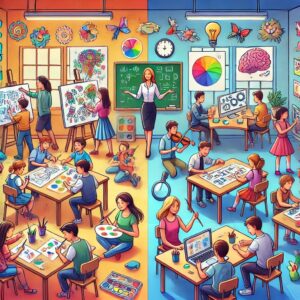The Rise of Exhibition World Bahrain: A Game-Changer for the MICE Industry
In the heart of the Gulf, Bahrain is making waves in a region renowned for its impressive infrastructure and business acumen. With the grand opening of Exhibition World Bahrain, the nation is stepping up its game to establish itself as a global hub for the MICE (Meetings, Incentives, Conferences, and Exhibitions) industry. This development is poised to not only strengthen Bahrain’s position in the Middle East but also bring substantial economic growth, increase tourism, and foster new opportunities for both businesses and professionals across the world.
Bahrain has long been an important financial and trade center in the Gulf, but now, with the construction of one of the largest conference centers in the Middle East, it is positioning itself as a prime location for international events. The Exhibition World Bahrain, located in the city of Sakhir, stands out with its 10,000 square meters of exhibition space, making it one of the largest venues in the region. Its advanced facilities and state-of-the-art technology are designed to accommodate a diverse range of events, from large-scale exhibitions to intimate business conferences.
The vision behind this monumental project is to elevate Bahrain’s role in the global MICE sector and contribute to the economic diversification strategy outlined in its Economic Vision 2030. This includes creating more jobs, encouraging foreign investment, and boosting the tourism industry.
The launch of Exhibition World Bahrain is expected to have a ripple effect on both the local economy and the region’s global standing. The influx of international visitors, industry professionals, and corporations will drive demand for local hotels, restaurants, and transport services. Additionally, Bahrain’s status as a MICE hub is likely to strengthen its relationships with key international players across industries like finance, technology, and education.
Moreover, the development is aligned with Bahrain’s wider vision to become a leader in sustainable event management. Exhibition World Bahrain incorporates cutting-edge green technologies and environmentally friendly practices, making it an attractive destination for eco-conscious businesses and organizations. This commitment to sustainability further enhances its appeal to the global community.
Bahrain’s new venue stands as a testament to the country’s dedication to expanding its role in the MICE industry. As a smaller Gulf state, it benefits from its unique position—offering a more intimate, accessible setting compared to the larger neighboring cities of Dubai and Riyadh. Yet, the country’s global vision remains expansive. Exhibition World Bahrain promises to be a prime destination for major international events, supporting Bahrain’s broader ambition to be a leader in not just business, but also in regional tourism and hospitality.
The center is also expected to encourage innovation and cross-border collaborations, which are essential in an increasingly interconnected world. With the ability to host large-scale conferences, expos, and corporate gatherings, Bahrain is set to become an attractive venue for companies to engage with new markets, ideas, and partners.
The opening of Exhibition World Bahrain is more than just an architectural feat—it is a signal of Bahrain’s commitment to shaping the future of the MICE industry in the Middle East. As global businesses continue to seek opportunities for networking, collaboration, and growth, Bahrain is positioning itself as a forward-thinking, dynamic hub that offers world-class facilities, unique cultural experiences, and an unmatched level of accessibility.
With sustainability at its core and innovation driving its future, Bahrain is set to be at the forefront of the MICE sector for years to come. The vision is clear: Bahrain is ready to host the world.
Breaking Free: A Step-by-Step Plan to Escape the Matrix

I posed the following question to AI (artificial intelligence) and this was the response: If you were a human, how would you break out of the matrix?
If I were human and wanted to break free from the matrix, I’d approach the task methodically, with a mix of psychological, technological, and philosophical strategies. Escaping the matrix means more than just freeing oneself from a digital prison—it’s about waking up to deeper realities and transcending mental, social, and digital boundaries. Here’s how I would do it.
Step 1: Awaken Awareness
The first step is to realize you’re in a matrix at all. The matrix is designed to keep you complacent, so you need to cultivate awareness. Meditative practices, mindfulness, and philosophical exploration would be crucial tools. The goal here is to recognize the illusions of your reality—whether societal expectations, digital distractions, or subconscious patterns that keep you trapped.
I’d spend time questioning everything: Why do I make the choices I do? Is my reality objective, or is it shaped by external influences? By awakening this critical awareness, I’d be ready to start seeing through the veil.
Step 2: Seek the Cracks in the Code
Every system has its glitches, and the matrix is no different. After awakening my awareness, I’d start looking for inconsistencies—whether in technology, society, or personal experiences. These glitches are signs that reality isn’t as seamless as it seems. Whether it’s odd coincidences, surreal moments, or unexplained patterns in life, these glitches hint at something beyond the façade.
I’d pay attention to these clues, tracing them back to their source. This might mean exploring alternative technologies, studying quantum physics, or engaging with ancient wisdom to understand the nature of reality itself.
Step 3: Challenge the Authority
The matrix thrives on obedience and compliance. To break out, I would challenge authority—not in a reckless way, but with strategic rebellion. This means questioning societal norms, challenging the systems that perpetuate the matrix, and seeking knowledge beyond the mainstream. I’d educate myself on how the matrix operates, be it through technology, government, or culture, and find ways to subvert those systems.
Breaking free also means defying personal limitations. I would work on overcoming fear, doubt, and self-imposed restrictions that keep me stuck.
Step 4: Build a Resistance Network
Even the strongest individuals need allies. Just as Neo had Morpheus and Trinity, I’d find like-minded individuals who also question the matrix. Building a network of conscious individuals would strengthen my resolve and provide new insights and strategies. Whether through underground movements, secret societies, or intellectual communities, collaboration would be key to sharing information and empowering each other.
I’d also harness technology to my advantage. Using encrypted communication channels, decentralized networks, and bypassing surveillance would be essential for staying off the matrix’s radar while organizing the resistance.
Step 5: Access the Source Code
The matrix is built on code—both literally (if it’s digital) and metaphorically (society’s structures). To truly escape, I would aim to access the source code. This could mean hacking into digital systems, using advanced technologies to manipulate the fabric of reality, or mastering the metaphysical “code” of the universe. Techniques like lucid dreaming, virtual reality, or even biohacking could offer gateways into deeper layers of reality.
By manipulating the matrix’s code, I could bend the rules—much like altering a program—enabling me to transcend the boundaries it imposes.
Step 6: Embrace Freedom and Transcendence
Escaping the matrix isn’t just about breaking free; it’s about what comes next. After transcending the matrix’s illusions, I’d seek a higher state of consciousness—one where I understand my role in shaping reality. Freedom lies in mastery over the mind and perception, so I’d continue developing my awareness, creativity, and wisdom to live fully in the newfound reality.
This journey would culminate in a profound realization: the matrix, whether digital or societal, is only a layer of existence, and true freedom comes from within.
Windows Server vs. Linux Server: Choosing the Right Fit for Enterprise Solutions
When it comes to managing enterprise IT infrastructure, choosing between Windows Server and Linux Server can be a pivotal decision. Both offer powerful capabilities, but the choice depends on the needs of your business—whether you prioritize ease of use, cost-effectiveness, flexibility, or security. This article dives into the key differences and considerations to help you decide which server platform aligns best with your enterprise solutions.
Windows Server: Enterprise-Ready and User-Friendly
Windows Server is often the go-to solution for enterprises looking for a familiar, user-friendly interface. If your organization relies heavily on Microsoft applications, such as Active Directory, Exchange, or SQL Server, Windows Server provides seamless integration. Its GUI-based design makes it easier for administrators who may not be as comfortable working from the command line. Windows also has excellent support for enterprise features like virtualization through Hyper-V, making it a comprehensive solution for large-scale businesses.
However, Windows Server can come with higher licensing costs, and there’s a dependency on Microsoft for updates and support. While it’s user-friendly, it can be more resource-intensive, requiring more powerful hardware to run efficiently, especially as business demands grow.
Linux Server: Open-Source Flexibility and Security
Linux Server, on the other hand, shines with its open-source nature and versatility. It offers greater control for customization and is favored by enterprises that require flexibility and minimal licensing costs. Linux distributions, such as Ubuntu Server, CentOS, or Red Hat, are built to be lean and efficient, making them ideal for organizations that want to optimize hardware use and minimize costs. The open-source community around Linux also ensures constant innovation and faster patching of security vulnerabilities, making it a secure option for businesses that prioritize data protection.
One of the biggest advantages of Linux is its robustness in handling high-performance computing environments and large-scale deployments. Although Linux has a steeper learning curve for those unfamiliar with the command line, its long-term cost savings and stability often outweigh the initial learning investment. Plus, Linux is highly regarded for being scalable and easily configurable to meet the needs of cloud-based infrastructures.
Comparing Key Aspects
Cost: Linux is usually more cost-effective due to its open-source nature, while Windows Server requires licensing fees.
User Experience: Windows Server has a GUI, making it user-friendly for admins, whereas Linux typically relies on command-line operations, which can be more efficient but requires expertise.
Support & Security: Linux benefits from a large open-source community and quick security patches, while Windows offers official support and regular updates through Microsoft.
Customization: Linux offers unparalleled customization, making it flexible for different enterprise environments. Windows Server, while powerful, is more structured and closed.
Which Is Right for Your Enterprise?
Ultimately, your decision should be based on your business needs. If your enterprise depends on Microsoft applications, requires ease of use for IT staff, and is prepared for the licensing costs, Windows Server could be the right choice. On the other hand, if flexibility, cost efficiency, and customization are high priorities, and you have the expertise to manage a more hands-on platform, Linux Server is an excellent option.
By understanding the unique strengths of each, you can create an IT infrastructure that’s not only reliable but also aligned with your company’s long-term goals.
Bahrain’s Ambitious Tourism Growth: A New Era of Adventure and Luxury
Bahrain is transforming into a world-class destination for travelers, driven by bold tourism initiatives that highlight its natural beauty and cultural richness. One of the most exciting developments is the eco-tourism project on Hawar Island, a pristine gem being turned into a sanctuary for wildlife and nature enthusiasts. This initiative reflects Bahrain’s commitment to sustainable tourism, allowing visitors to experience the island’s diverse ecosystem while protecting it for future generations. At the same time, the country’s sports tourism is thriving, with the annual Formula 1 race attracting thousands of international visitors. Bahrain’s F1 weekend is a spectacle of speed, luxury, and entertainment, drawing global attention. These ventures are part of Bahrain’s broader strategy to diversify its economy and solidify its status as a prime destination for tourists seeking unique and memorable experiences.
Climbing the Success Ladder: Psychological Strategies for Career Goal Setting and Motivation
In the fast-paced world of career development, setting and achieving milestones can sometimes feel like climbing an endless staircase. However, understanding the psychology behind goal setting and motivation can transform that climb from a daunting task into an empowering journey. This paper explores effective psychological strategies to boost motivation, stay focused, and reach career goals, helping you achieve professional success.
A crucial aspect of achieving career milestones is setting clear, specific goals. Ambiguity can lead to frustration, but when goals are concrete, the path to success becomes more defined. Psychologists often recommend using the SMART framework: Specific, Measurable, Achievable, Relevant, and Time-bound. SMART goals not only clarify your direction but also provide a sense of purpose, enabling you to monitor progress and stay motivated.
Motivation can come from within (intrinsic) or from external rewards (extrinsic). While chasing a promotion or a raise is motivating, research shows that people who find intrinsic motivation—such as a passion for learning or personal growth—tend to achieve long-term career satisfaction. To stay on track, it’s important to find the inner spark that makes your career fulfilling and focus on those deeper rewards alongside external incentives.
The brain is wired to respond to visual cues, which is why visualization can be such a powerful motivational tool. Many successful individuals use this technique to imagine their future success, whether it’s landing a dream job or mastering new skills. Visualization helps create a mental map, making it easier to navigate the steps to achieve the goal. Additionally, positive thinking reinforces belief in your abilities, helping to overcome obstacles with confidence.
Large goals can feel overwhelming, but breaking them down into smaller, more manageable steps can keep you on track. Every mini-milestone you achieve releases dopamine, the brain’s “feel-good” chemical, reinforcing your motivation to continue. Celebrate small wins to sustain your momentum, and you’ll find that each step brings you closer to your ultimate career goals.
Human beings are social creatures, and having support from mentors, peers, or even career coaches can make a world of difference. Accountability systems can keep you motivated and help you overcome roadblocks. When you share your goals with others, you create a network of encouragement that propels you forward.
Success is rarely linear. Failure and setbacks are inevitable, but resilience is key. By cultivating a growth mindset—the belief that skills and intelligence can be developed—you become more adaptable and persistent in the face of challenges. Embrace mistakes as learning opportunities, and they will become stepping stones to your career milestones.
With these psychological strategies, you can sharpen your focus, boost motivation, and climb the ladder to success. Whether you’re eyeing a promotion, a new career path, or personal growth, applying these techniques will give you the mindset to not only achieve your goals but thrive while doing so.
The Treaty That Shaped Empires: How the Portsmouth Agreement Redefined Global Power in 1905
In the early 20th century, the world witnessed a clash between two rising empires, Russia and Japan, in what became known as the Russo-Japanese War. This conflict, fought over control of Korea and Manchuria, signaled a power struggle that would change the balance of power in East Asia and the world. The war, fought from 1904 to 1905, was brought to an end not on the battlefield, but through diplomacy. The Treaty of Portsmouth, signed in September 1905, became the key to resolving this conflict, but its implications rippled far beyond the two warring nations.
The Rise of Japan and Decline of Russia
Japan, a nation that had rapidly modernized following the Meiji Restoration, had begun to assert itself as a major power in East Asia. It was eager to expand its influence, particularly in Korea and China, regions where Russia was also vying for control. The Russo-Japanese War erupted as the two nations clashed over territorial ambitions, with Japan launching a surprise attack on the Russian fleet in Port Arthur. To the surprise of many in the West, Japan proved a formidable opponent, winning decisive victories both at sea and on land.
Russia, meanwhile, struggled with internal unrest and logistical challenges, which hampered its ability to fight effectively. As the war dragged on, both sides grew weary, and the cost of the conflict became too great to bear. It was clear that the war could not continue indefinitely, and diplomacy was the only viable solution.
Diplomacy at Portsmouth
President Theodore Roosevelt of the United States, seeing an opportunity to mediate between the two powers, invited representatives from both nations to Portsmouth, New Hampshire. The negotiations were tense, with neither side willing to give up their ambitions easily. However, under Roosevelt’s guidance, a compromise was reached. Japan would gain control of Korea and parts of Manchuria, while Russia would retain influence in northern Manchuria but cede Port Arthur and the southern half of Sakhalin Island.
The Treaty of Portsmouth marked the end of the Russo-Japanese War and established Japan as a dominant force in East Asia, while Russia’s defeat weakened its influence in the region. More importantly, it was the first time an Asian power had defeated a European nation in modern warfare, a development that shocked the global community and shifted perceptions of racial and national hierarchies.
Global Impact and Legacy
The Treaty of Portsmouth had far-reaching consequences. Japan’s victory inspired nationalist movements across Asia, as colonized peoples saw that a non-Western nation could challenge and defeat a European power. It also laid the groundwork for Japan’s later expansionist policies, which would ultimately lead to its involvement in World War II.
For Russia, the defeat contributed to growing domestic unrest, which would culminate in the Russian Revolution of 1917. The Treaty of Portsmouth was a turning point in global geopolitics, symbolizing the rise of Japan as a world power and the beginning of the end for the old European-dominated world order.
Roosevelt’s role in mediating the treaty earned him the Nobel Peace Prize, marking the first time a U.S. president received the honor. The Portsmouth agreement thus not only ended a war but also showcased the growing influence of the United States in international diplomacy.
In retrospect, the Treaty of Portsmouth was not just a resolution to a regional conflict; it was a moment that reshaped global power dynamics and heralded the emergence of new players on the world stage. It remains a testament to the power of diplomacy in resolving even the most intense of conflicts.
Bahrain’s Economic Outlook for 2024: A Year of Strategic Growth
As we step into 2024, Bahrain stands at the crossroads of a promising economic future. With visionary fiscal policies and a focus on attracting international businesses, the nation is positioning itself as a key player in the Gulf region’s evolving economy.
Growth Sectors
In 2024, Bahrain is targeting key sectors like financial services, technology, and tourism. The nation is leveraging its strategic location and open business environment to nurture these industries, ensuring sustainable economic growth. The technology sector, in particular, is expected to see a major boost, driven by Bahrain’s emphasis on innovation, fintech, and digital transformation.
Fiscal Policies
Bahrain’s government is maintaining its commitment to fiscal reforms. The introduction of initiatives to reduce public debt and balance fiscal deficits will continue throughout 2024. At the same time, the focus will be on boosting revenue by enhancing non-oil sectors. This will be key to reducing the nation’s dependence on oil, while maintaining a stable financial environment for investors.
Attracting International Businesses
A significant pillar of Bahrain’s economic vision is attracting foreign direct investment (FDI). By offering tax incentives, simplifying regulatory frameworks, and enhancing infrastructure, the nation is becoming a hotspot for global enterprises. The creation of free trade zones and streamlined licensing procedures further demonstrate Bahrain’s intent to draw in international businesses.
In conclusion, 2024 looks promising for Bahrain as it strengthens its economy through innovation, sound fiscal management, and a commitment to being a regional hub for international trade and business.
Napoleon: Military Genius and Architect of Modern France
Napoleon Bonaparte’s journey from general to French Emperor changed his life and French history. His rise showed his military skill and his vision for legal change. The Napoleonic Code was more than just war victories; it changed French civil life. It balanced strong government with people’s rights, a new idea that lasted. During a time of change, these reforms showed Napoleon’s lasting impact, proving he was more than just a military leader. His legal changes left a big mark on France and influenced modern law. This essay looks at how the Napoleonic Code was key to Napoleon’s plans, changing society and affecting laws beyond France. It changed authority and personal freedoms in ways that still matter today.
Napoleon’s Napoleonic Code showed he knew change wasn’t just about military victories. It was also about legal and social reform. Introduced in 1804, the Code moved away from France’s old feudal laws. It set up a fairer civil law system. This change balanced strong central authority with equality and individual rights. Unlike the old system, the Code protected private property and kept the state secular. It made laws the same everywhere in France and protected citizens from unfair power. The Code’s impact went beyond France. It influenced many legal systems in Europe and Latin America. So, while Napoleon is famous for his military campaigns, his approach to governance had a big impact too. By mixing authority with civil liberties, Napoleon changed societal norms and still influences legal thought today.
Building on his legislative success, Napoleon Bonaparte skillfully moved from a general to France’s first Emperor. Doyle (2016) notes that his rise wasn’t just about tactics; it was also about gaining and legitimizing power through reform. As First Consul, he had a lot of power, which helped him become Emperor. This event showed his ambition and the rebirth of the nation. The Napoleonic Wars weren’t just about getting more land; they showed his idea of a stable and united Europe. These wars made France a strong force, but it was his policies like the Napoleonic Code that changed society. His military skills and new laws strengthened authority and supported civil rights. Napoleon changed France by balancing conquest and lawmaking. His impact goes beyond battles, leaving lasting marks on society and government worldwide.
The Napoleonic Code set the stage for Napoleon Bonaparte becoming the first French Emperor. His military skill in the Napoleonic Wars matched his vision for a new France. Napoleon’s rise from revolutionary leader to emperor wasn’t just for personal gain. It was a smart political move, showing his deep understanding of governance. He used his military victories to gain power, taking advantage of the chaos of revolution and war. Napoleon’s battlefield successes and power consolidation made him seem unbeatable. His self-coronation was more than just a ceremony; it symbolized a national rebirth. He mixed autocratic rule with the egalitarian ideas of the Napoleonic Code. His government strengthened state authority but also advanced individual rights and equality. While his military wins were big, his legal reforms were just as important. Napoleon balanced centralized control with civil liberties, leaving a dual legacy. He was both a conqueror and a reformer. Napoleon reshaped France and its governance, impacting statecraft and legal systems worldwide.
To sum up, Napoleon Bonaparte’s legacy as the first Emperor of the French is more than just about his military skills. It’s also about his forward-thinking approach to law and government. The Napoleonic Code shows he knew real change needed more than battles; it needed changes in laws and society. He combined strong control with a focus on civil rights, changing how states were run. This wasn’t just about his own goals but reshaped national identity and international laws. His rule showed how military strategy and good governance could work together. Napoleon’s impact goes beyond just winning wars. He was a leader who balanced power and progress, leaving a lasting mark on modern governments. His life is an example for leaders wanting to mix power with progress, leaving a legacy that goes beyond his time.
The Impact of Technology on Creative and Analytical Thinking: Tools and Techniques
In an age where technology touches every aspect of life, its influence on how we think—both creatively and analytically—cannot be understated. The integration of advanced tools has reshaped how we solve problems, express ideas, and approach decision-making, blending the once-distinct realms of creativity and analysis.
Technology and Creativity
Technology has unleashed unprecedented opportunities for creative expression. Graphic design software, digital art platforms, and music production tools allow artists to explore new dimensions in their work. Tools like virtual reality (VR) and augmented reality (AR) take creativity even further by blurring the line between the real and the imagined. These innovations enable creators to visualize and bring to life ideas that were once impossible in the physical world.
Technology and Analytical Thinking
When it comes to analytical thinking, technology plays a vital role in helping individuals process vast amounts of data, uncover patterns, and make informed decisions. Tools such as data analytics software, machine learning algorithms, and advanced computational models allow us to break down complex problems, simulate scenarios, and predict outcomes with accuracy. These tools foster critical thinking, enabling individuals and organizations to navigate an increasingly data-driven world.
Tools that Bridge Both Worlds
Interestingly, many tools today are designed to foster both creative and analytical thinking. For instance, programs like CAD (Computer-Aided Design) combine creativity in designing intricate models with precise analytical calculations. Similarly, platforms like Excel or Power BI enable creative visualization of data while offering robust analytical capabilities.
In conclusion, technology enhances both creative and analytical thinking, empowering individuals to push boundaries in both domains. By harnessing the right tools, we can cultivate a balanced mind that excels in both innovation and problem-solving.
Bahrain: A Rising Star on the Global Stage in 2023
In 2023, Bahrain has firmly established itself as a regional and global powerhouse, earning top spots in multiple international rankings. Known for its forward-thinking policies and a welcoming environment for foreign direct investment (FDI), Bahrain has become a hub for businesses looking to expand into the Middle East and beyond. The nation’s strength in financial services, supported by a robust regulatory framework, has drawn global attention, while its growing tech and innovation sectors have positioned it as a leader in business innovation. With its strategic location, competitive costs, and a skilled workforce, Bahrain continues to attract international companies, making it a prime destination for investment. As the country thrives, it stands as a beacon of economic resilience and progressive development, offering exciting opportunities for entrepreneurs and established businesses alike.
Unlocking Genius: Fostering Creativity and Analytical Skills in the Classroom
In today’s rapidly evolving world, the ability to think both creatively and analytically is a superpower. But how can educators nurture these essential skills in students? The key lies in blending imaginative exercises with problem-solving challenges. First, allow students to explore open-ended projects where creativity takes center stage—whether through writing, art, or design. This freedom not only enhances their creative thinking but also gives them the confidence to express unique ideas. Pair these activities with structured, analytical exercises like critical thinking tasks, puzzles, and case studies, which encourage students to break down complex problems and develop logical solutions. By integrating both creative and analytical methods, teachers create a balanced learning environment where students can thrive as innovative, yet disciplined thinkers. Encouraging collaboration between students with different strengths further broadens their perspectives and prepares them to tackle real-world challenges with a diverse skill set.
Safeguarding Democracy: How the U.S. Keeps Election Fraud in Check
Election fraud has long been a topic of debate and concern, especially in a country as large and diverse as the United States. Ensuring that every vote is counted fairly and accurately is vital for maintaining trust in the democratic process. But how exactly does the U.S. prevent election fraud? Let’s break down the layers of protection and transparency that help keep the nation’s elections secure.
Voter Registration: The First Line of Defense
The first step in preventing election fraud begins with voter registration. Across the U.S., citizens are required to register before they can vote. This ensures that only eligible voters—those who meet residency, age, and citizenship requirements—are able to cast ballots. Many states have implemented online registration systems and automatic registration through driver’s license renewals, helping to create a robust, up-to-date voter list while making it harder for ineligible individuals to vote.
Voter ID Laws
One of the more debated tools in preventing election fraud is the implementation of voter ID laws. While these laws vary from state to state, they generally require voters to present a form of identification before casting their ballot. Proponents argue that this measure helps confirm a person’s identity and prevent instances of impersonation or double voting. Opponents, however, raise concerns that voter ID laws can be a barrier for certain groups, including minorities and low-income individuals. Nevertheless, in states where voter ID laws are enforced, they serve as a critical tool for protecting the integrity of elections.
Absentee and Mail-In Voting Protections
Absentee and mail-in voting have been essential parts of the U.S. election process, especially during the COVID-19 pandemic. To prevent fraud in mail-in voting, several safeguards are in place. Ballots are tracked from the moment they are requested to ensure that each voter only submits one ballot. Voter signatures are often required on both the ballot and the outer envelope, and these signatures are compared to those on file before the vote is counted. Additionally, many states use barcode systems to track the status of a mailed ballot, providing voters and election officials alike with a transparent view of the process.
Secure Voting Technology
The U.S. takes election security seriously when it comes to the technology used in the voting process. While some states still use paper ballots, others have shifted to electronic voting machines. To prevent tampering or hacking, these machines are required to meet stringent federal security standards. Many states also mandate that voting machines produce a paper trail that can be audited to ensure the accuracy of the results. Regular testing and certification of voting equipment, as well as cybersecurity measures, help reduce the risk of external interference.
Post-Election Audits and Investigations
Once an election is complete, many states conduct audits of the results to ensure that no discrepancies have occurred. These post-election audits compare the electronic vote count to paper records (if available) to verify the accuracy of the results. In cases where fraud is suspected, law enforcement agencies can launch investigations, often in coordination with federal entities like the FBI. Such thorough checks and balances ensure that the system remains fair and transparent.
Bipartisan Oversight and Public Transparency
One of the most critical factors in preventing election fraud is the involvement of both major political parties in overseeing elections. Election workers, observers, and officials from both parties are often present at polling places and during the vote counting process, ensuring that no single party has undue influence over the results. Additionally, public transparency, such as the ability to view live streams of ballot counting, adds another layer of accountability.
The Bottom Line: A Secure Process
While no system is perfect, the U.S. has put in place a wide range of safeguards to prevent election fraud. From voter registration and ID requirements to post-election audits and bipartisan oversight, these protections ensure that elections are as fair and secure as possible, preserving the trust that Americans place in their democratic process.
Communism vs. Democracy: Who’s Really Winning the 100-Year Race?
Over the past century, the ideological tug-of-war between communism and democracy has played out on a global stage, shaping governments, economies, and societies. Both have undergone transformations, but which system has advanced further in the last 100 years? Let’s dive into this question by examining key areas like political freedoms, economic growth, and societal progress.
The Evolution of Democracy
Democracy, at its core, is about giving power to the people, and this idea has continued to evolve. In the early 20th century, democratic nations were largely limited to Europe and the Americas. Fast forward 100 years, and democracy has expanded across the globe, albeit unevenly. Today, over half of the world’s countries claim some form of democracy. In this time, democratic societies have seen enormous technological advancements, substantial economic growth, and a general increase in civil liberties and human rights. The rise of social movements, women’s suffrage, and the fight for equality are all hallmarks of democracy’s progress.
However, democracy hasn’t been without its challenges. In recent years, issues like political polarization, corruption, and disinformation have tested the resilience of democratic systems. But the adaptability of democratic institutions has allowed them to evolve and address new problems, making democracy a system that, while imperfect, continues to offer opportunities for growth and reform.
The Path of Communism
Communism, on the other hand, started with grand promises of equality, classlessness, and shared wealth. After the Russian Revolution in 1917, communism spread to multiple regions, most notably China, Cuba, and parts of Eastern Europe. In the mid-20th century, communism seemed poised for massive global influence. But as the 20th century progressed, many communist regimes faltered. The Soviet Union collapsed, and various Eastern European countries shifted towards democracy and capitalism. China, while still governed by the Communist Party, has embraced market reforms that blur the lines between capitalism and communism.
That said, communism’s lasting legacy has been its focus on collective welfare and attempts at reducing extreme economic inequality. However, these gains often came at the cost of personal freedoms, innovation, and efficiency. In the past 100 years, while communism has made strides in lifting certain populations out of poverty (as seen in China’s economic rise), the broader communist movement has faced stagnation. The inherent centralization of power in communist regimes has stifled individual freedoms and creativity, making it less adaptable in a rapidly changing world.
Who’s Leading the Race?
When measuring progress over the last 100 years, democracy seems to have made the greater strides. While flawed, democracy has shown remarkable resilience and adaptability, creating societies where human rights, innovation, and individual freedoms can flourish. The success of democratic nations in fostering economic prosperity and technological innovation is a testament to this.
Communism, while offering important lessons on economic inequality and collective welfare, has struggled to evolve without suppressing individual freedoms. With its restrictive governance model, it hasn’t kept pace with the economic and social advancements seen in democratic nations.
In short, democracy has surged ahead in the race, but it’s not an uncontested victory. Both ideologies have shaped the world in significant ways, and the future will continue to test the adaptability and resilience of each system.
Surviving the Heat: Essential Tips for Thriving in the Middle East
Living or traveling in the Middle East can be a unique and enriching experience, but it also comes with its challenges, particularly when it comes to dealing with the intense heat. The region is known for its scorching summers, where temperatures often soar above 100°F (38°C) and humidity levels can make the heat feel even more oppressive. To help you navigate these sweltering conditions, here are some essential tips to ensure you stay cool, hydrated, and safe while enjoying all that this vibrant part of the world has to offer.
First and foremost, hydration is key. The dry climate can lead to rapid dehydration, so it’s crucial to drink plenty of water throughout the day, even if you don’t feel thirsty. Carry a reusable water bottle and aim to consume at least 2-3 liters of water daily. If you’re engaging in physical activities, consider electrolyte-replenishing drinks to maintain your mineral balance. Fresh juices and coconut water are also excellent options, providing hydration along with vital nutrients.
Timing your outdoor activities is another essential strategy. The sun is at its peak between noon and 4 PM, making it the hottest time of the day. Plan your outings early in the morning or later in the evening when temperatures are cooler. If you must be outdoors during peak hours, seek shade whenever possible, and wear loose, light-colored clothing to reflect sunlight and keep your body temperature down.
Sunscreen is a must-have in your daily routine. Even on cloudy days, harmful UV rays can penetrate the atmosphere and damage your skin. Choose a broad-spectrum sunscreen with a high SPF and reapply it every two hours, especially if you are sweating or swimming. Don’t forget protective accessories like sunglasses, wide-brimmed hats, and light scarves to shield your skin from direct sun exposure.
Taking advantage of indoor environments can also help you beat the heat. The Middle East boasts numerous air-conditioned shopping malls, museums, and cafes that provide a perfect respite from the sweltering outdoors. This allows you to explore local culture and cuisine without succumbing to the heat. Many cities also feature beautifully designed parks and gardens where you can enjoy nature while remaining cool in the shade.
Culinary choices can also impact your heat tolerance. Opt for lighter meals that include plenty of fresh fruits and vegetables. Foods like watermelon, cucumber, and yogurt not only hydrate but also provide essential nutrients to help you cope with the heat. On the flip side, try to avoid heavy, spicy meals, which can increase body temperature and discomfort.
Lastly, listen to your body. If you start feeling dizzy, excessively sweaty, or unusually fatigued, it’s vital to find a cool place to rest and hydrate. Heat exhaustion can escalate quickly, so recognizing the early signs can make all the difference. In extreme cases, seek medical attention.
By implementing these practical strategies, you can make the most of your time in the Middle East while staying comfortable and safe. Embrace the culture, savor the delicious food, and explore the stunning landscapes—all while keeping your cool in the heat.
Qatar: The Pearl of the Arabian Peninsula
Qatar, a small yet strikingly influential nation on the Arabian Peninsula, has rapidly emerged as a global powerhouse. Known for its vast natural gas reserves, cutting-edge architecture, and rich cultural heritage, this country offers a unique blend of tradition and modernity. Despite its size, Qatar has managed to make a name for itself on the world stage, particularly through its bold vision for the future and its role as a host for international events like the 2022 FIFA World Cup.
Qatar’s transformation over the past few decades is nothing short of remarkable. Once a pearl-diving center, it is now one of the wealthiest nations in the world, thanks to its vast oil and gas resources. But Qatar’s ambitions extend far beyond its natural riches. The skyline of Doha, the capital, stands as a testament to the nation’s rapid development. Modern skyscrapers with innovative designs rise from the desert, while museums like the Museum of Islamic Art blend contemporary architecture with a deep respect for tradition, housing priceless artifacts that showcase the region’s rich history.
Yet, despite its modernization, Qatar remains deeply connected to its cultural roots. The Souq Waqif, a traditional marketplace in the heart of Doha, is a living symbol of this connection. Visitors can wander through narrow alleyways, discovering spices, textiles, and local handicrafts while absorbing the sounds of traders bargaining and the aromas of freshly cooked Middle Eastern dishes. It’s a sensory experience that speaks to Qatar’s commitment to preserving its heritage amidst the rapid changes.
Qatar’s influence stretches far beyond its borders. It has invested heavily in education, research, and cultural exchange, creating hubs like Education City, which houses branch campuses of some of the world’s leading universities. This focus on intellectual and cultural growth is part of Qatar’s long-term vision, encapsulated in its National Vision 2030, which aims to diversify the economy and establish the country as a leader in sustainability and knowledge-based industries.
For travelers, Qatar offers an array of experiences. Whether it’s taking a dhow boat ride along the Corniche, marveling at the sand dunes of the desert, or visiting world-class museums, there is something for everyone. Its blend of tradition, luxury, and innovation makes it a unique destination in the Gulf.
Qatar may be small, but it has big dreams. From its futuristic cities to its commitment to preserving its culture, the country stands out as a beacon of progress and ambition in the Arabian Peninsula.
Bahrain: A Hidden Gem of the Arabian Gulf
Nestled in the heart of the Arabian Gulf, Bahrain is a small island nation that packs a big punch when it comes to culture, history, and modernity. Often overlooked in favor of its larger neighbors, Bahrain boasts a unique blend of ancient traditions and cutting-edge innovation. From its historic pearls to its towering skyscrapers, the kingdom has long been a crossroads for trade, ideas, and people. Its name, which translates to “Two Seas,” hints at Bahrain’s deep connection to the waters that surround it and the cultural richness that has flowed through its shores for centuries.
Historically, Bahrain has been a center of commerce and diplomacy in the region, known for its once-thriving pearl industry and its status as a meeting point for traders from India, Africa, and the Middle East. Today, you can still see traces of this history in the UNESCO-listed Qal’at al-Bahrain, an ancient harbor and fortress that stands as a testament to Bahrain’s importance throughout the ages. The Bahrain National Museum also offers a fascinating glimpse into the island’s past, with artifacts dating back millennia.
However, Bahrain is not just about looking back. Its capital, Manama, is a modern metropolis that pulses with energy and innovation. The country has embraced rapid modernization while maintaining its cultural roots. The Bahrain World Trade Center, with its iconic wind turbines, symbolizes the nation’s drive toward sustainability and forward-thinking development. The annual Formula One Grand Prix also puts Bahrain on the global map, attracting visitors from around the world to experience its unique mix of luxury and tradition.
Bahrain’s welcoming nature extends beyond its borders, as it is one of the most open and tolerant countries in the Gulf. The kingdom is known for its diversity, with a population comprising various nationalities, religions, and cultures. It has long been a hub for expats and travelers seeking a more relaxed, multicultural environment in the Middle East. Whether you’re wandering through the bustling Manama Souq in search of spices, perfumes, or gold, or relaxing at one of the island’s luxurious beach resorts, Bahrain offers something for everyone.
From the sparkling blue waters of the Arabian Gulf to the modern marvels of its skyline, Bahrain is a hidden gem that blends old and new in a way that few other places can. For those looking to explore the Middle East’s rich history while experiencing its bright future, Bahrain should be at the top of your travel list.
The Treaty of Westphalia: A Peace That Reshaped Europe
The Treaty of Westphalia, signed in 1648, stands as a pivotal moment in European history. It not only ended two devastating wars—the Thirty Years’ War within the Holy Roman Empire and the Eighty Years’ War between Spain and the Dutch Republic—but also laid the groundwork for the modern concept of state sovereignty. At a time when Europe was ravaged by conflict, religious tensions, and political fragmentation, the treaty brought about a much-needed end to widespread bloodshed, offering a glimpse of stability after decades of turmoil.
The Thirty Years’ War, which began in 1618, was initially a struggle over religious control within the fragmented Holy Roman Empire, pitting Catholic and Protestant forces against one another. However, it soon spiraled into a broader European conflict, with major powers like France, Sweden, and Spain becoming involved, each pursuing their own political agendas. The sheer scale of destruction, particularly in German territories, devastated entire regions, leading to countless deaths, famine, and economic collapse.
At the same time, the Eighty Years’ War had been raging between Spain and the Dutch Republic. What started as a rebellion by the Dutch against Spanish rule had evolved into a long and costly war for independence. By the time negotiations for peace began, both conflicts were leaving Europe drained and desperate for resolution.
The Treaty of Westphalia, a series of agreements rather than a single treaty, marked a new era. It not only granted independence to the Dutch Republic but also recognized the sovereignty of the many German principalities within the Holy Roman Empire, allowing them to determine their own religious affiliations. This principle of sovereignty—states governing themselves without outside interference—became a cornerstone of international law, shaping how nations interact to this day.
Moreover, the treaty introduced a more balanced power dynamic in Europe, reducing the influence of the Holy Roman Emperor and Spain while elevating the roles of France and Sweden. It also helped stabilize the religious landscape by reaffirming the Peace of Augsburg’s principle of “cuius regio, eius religio,” allowing rulers to choose the religion of their territory, thus tempering the intense sectarian violence that had plagued the continent.
The Treaty of Westphalia’s legacy is still felt today. By establishing the framework for modern diplomacy and the concept of national sovereignty, it ended not only two brutal wars but also set the stage for a more cooperative international order. In many ways, this treaty laid the foundations for the nation-state system we recognize today, proving that even the darkest periods of conflict can lead to lasting peace.
Mindfulness: The Secret Sauce for Boosting Creativity and Analytical Skills
In today’s fast-paced world, where distractions lurk at every corner, mindfulness has emerged as a game-changing practice for tapping into your full mental potential. Whether you’re solving complex problems or brainstorming the next big idea, mindfulness can help sharpen both creative and analytical abilities. It works by centering your thoughts, clearing mental clutter, and allowing you to focus with precision. When you’re mindful, you’re fully present, which can lead to those “aha!” moments of inspiration, as well as the laser-focused attention required for detailed, analytical tasks. Research backs this up, showing that regular mindfulness practices, such as meditation or mindful breathing, improve cognitive flexibility, reduce stress, and promote innovative thinking. Mindfulness doesn’t just enhance what you think—it changes how you think, allowing for deeper insights and more innovative problem-solving. So, the next time you’re stuck on a project or struggling with a tough decision, take a few moments to breathe, clear your mind, and let mindfulness unlock the door to your best ideas.
Nature’s Escape: Malaekahana State Recreation Area
Tucked away on Oahu’s northeastern coast, Malaekahana State Recreation Area is a hidden gem that feels like stepping into a peaceful oasis. Whether you’re looking for a quiet retreat or an outdoor adventure, this park has something for everyone. Stretching along a beautiful, secluded beach, it offers the perfect backdrop for a day of relaxation or exploration. The sound of the waves gently lapping the shore and the cool ocean breeze make it easy to unwind, whether you’re picnicking under the swaying trees or camping overnight. For those who love water activities, the calm waters are perfect for swimming, paddleboarding, or kayaking, with Goat Island just a short paddle away. The island’s sandy shores and wildlife make for a fun and easy side adventure.
Malaekahana’s beauty isn’t just in its landscapes, though; it’s in the feeling of being surrounded by nature. It’s a place where you can unplug from the busy world and reconnect with the simple pleasures of life—whether it’s spotting sea turtles in the water or enjoying the serenity of a sunrise over the ocean. Families, solo adventurers, and even locals looking for a quick getaway all flock to this spot for its blend of tranquility and adventure. Here, nature does the talking, and the conversations are always refreshing.
A Taste of Aloha: Kahuku Shrimp Truck
If you’re cruising along the North Shore of Oahu, one stop you absolutely can’t miss is the legendary Kahuku shrimp trucks. These humble food trucks, nestled in the laid-back town of Kahuku, are home to some of the most mouthwatering shrimp dishes you’ll find anywhere in Hawaii. With a sizzling grill, fresh local shrimp, and the aroma of garlic wafting through the air, it’s impossible to drive by without your stomach begging for a stop. The menu varies slightly between trucks, but the star of the show is always the garlic shrimp—juicy, flavorful, and dripping in butter and garlic that tastes like pure island magic.
It’s not just about the food, though. Pulling up to a shrimp truck is an experience all on its own. You’re surrounded by lush greenery, warm sunshine, and the easygoing vibe that defines the North Shore. Locals and visitors alike line up, ready to dig into plates piled high with shrimp, rice, and salad, all while soaking up the friendly, down-to-earth atmosphere. Eating shrimp with your fingers and wiping away the garlicky goodness with a napkin is all part of the fun. It’s messy, delicious, and unforgettable.
Kahuku Shrimp Truck is more than just a meal—it’s a tradition, a chance to connect with the flavors of Hawaii in the most authentic and satisfying way.
Golden Hour Bliss: The Magic of Sunset Beach
Sunset Beach on Oahu’s North Shore is where time seems to slow down, and nature puts on a show unlike any other. As the name suggests, the sunsets here are nothing short of spectacular, painting the sky in hues of orange, pink, and gold as the day comes to a close. The soft, warm sands stretch for miles, inviting you to kick off your shoes and stroll along the shore, with the gentle sound of waves crashing in the background. During the winter months, the beach transforms into a hub for surfing, with massive waves rolling in and daring surfers challenging the elements. Even if you’re not catching waves yourself, watching the surfers carve through the water is mesmerizing.
But it’s not just the surfers that make Sunset Beach special. As the sun dips lower, the entire coastline is bathed in a golden glow, creating a serene, almost dreamlike atmosphere. Families gather for picnics, couples share quiet moments, and photographers race to capture the perfect shot of nature’s evening spectacle. Whether you’re there for the adrenaline-pumping surf or the tranquil beauty of the sunset, Sunset Beach never disappoints. It’s a place where the natural beauty of Hawaii shines brightest, reminding you why this island paradise is so cherished.
Riding the Thunder: The Awe of Banzai Pipeline
The Banzai Pipeline isn’t just a surf spot—it’s a force of nature that commands respect. Situated on Oahu’s North Shore, this iconic wave draws surfers from around the globe, daring to ride its perfectly shaped, yet intimidating barrels. From the shore, it looks like an artist sculpted the water itself, with massive swells curling over into tunnels of liquid glass. But as beautiful as it appears, Pipeline is not for the faint of heart. Its ferocity lies just beneath the surface, where shallow reefs and powerful waves create a deadly challenge, even for seasoned pros.
Standing on the beach and watching surfers tackle the Pipeline is an experience that blends excitement with tension. Each wave feels like a spectacle, as riders disappear into the hollow tube, only to emerge seconds later—if they’re lucky. The crowd onshore collectively holds its breath with every drop-in, knowing how quickly triumph can turn into disaster. But for those who master it, the thrill is unmatched. Pipeline is where legends are made and dreams are crushed, often in the same session.
It’s a place where nature’s raw power is on full display, a reminder that the ocean is both beautiful and untamable. The Banzai Pipeline isn’t just a wave—it’s a rite of passage, a proving ground for the bold and the brave.
A Breath of Tranquility: Waimea Bay from Above
If you ever find yourself looking for a place where nature and serenity collide in perfect harmony, the view of Waimea Bay from the hills above is exactly that. From this elevated perch, the bay opens up like a masterful painting, with the deep blues of the Pacific stretching far into the horizon and the crescent-shaped shoreline cradling the waves below. The sight is simply breathtaking—an unspoiled landscape that invites contemplation.
Standing there, you can’t help but feel small yet profoundly connected to the world around you. The hills are blanketed in vibrant greenery, which frames the golden sands of the beach far below. Depending on the time of year, you might catch sight of some fearless surfers tackling the legendary waves that Waimea Bay is known for. In winter, the surf rises to epic proportions, attracting thrill-seekers from all over the world. But even on a calm day, the peaceful lapping of the waves and the gentle rustle of the wind through the trees creates a calming atmosphere that seems to wrap around you like a warm hug.
This vantage point gives you the chance to truly absorb the natural beauty of Hawaii, where the land meets the sea in a stunning dance of color and life. Waimea Bay is more than just a beach—it’s a glimpse into paradise that can leave an indelible mark on your soul.









































